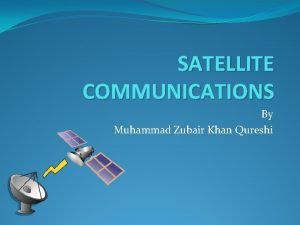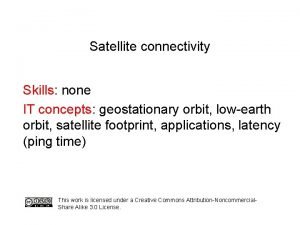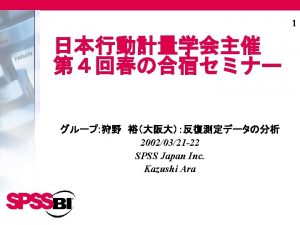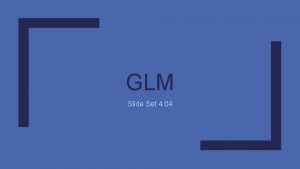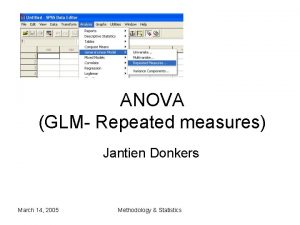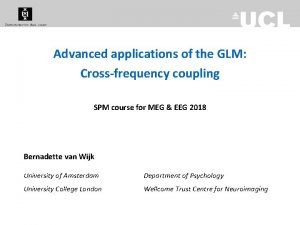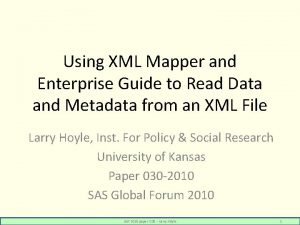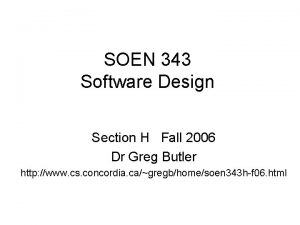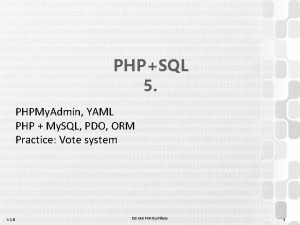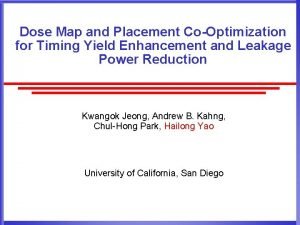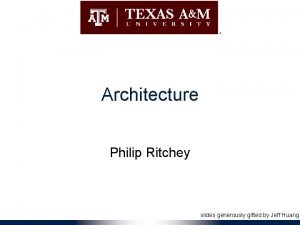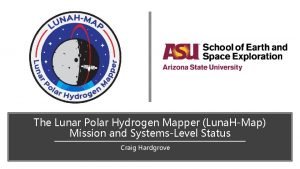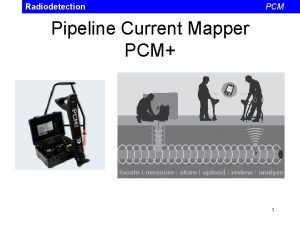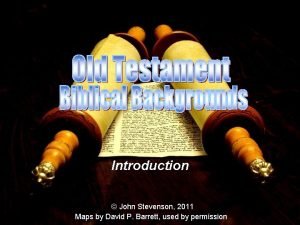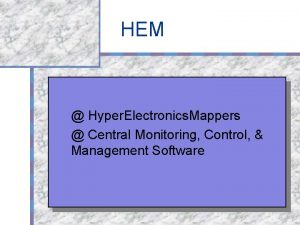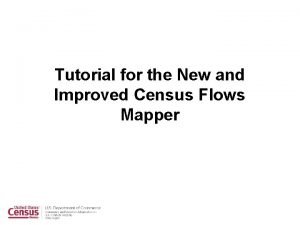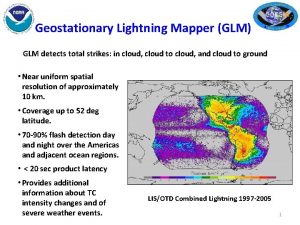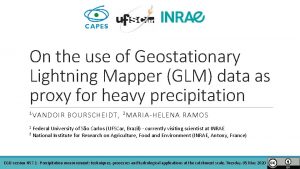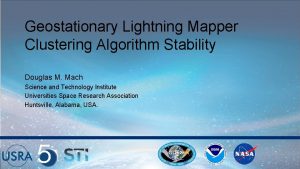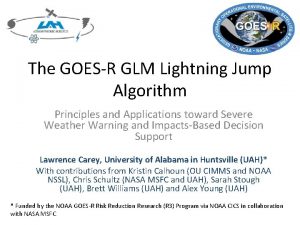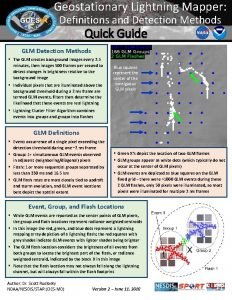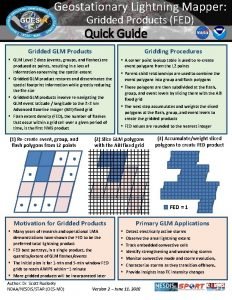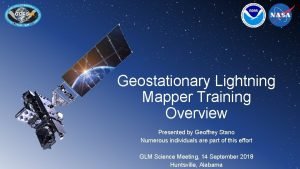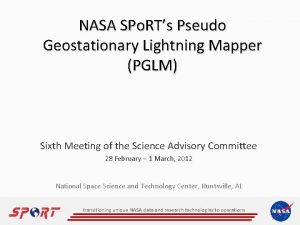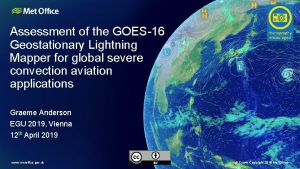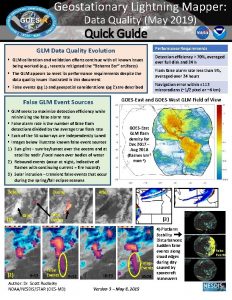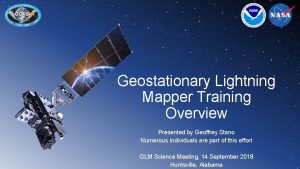GOESR Geostationary Lightning Mapper GLM Algorithm and Instrument




















- Slides: 20

GOES-R Geostationary Lightning Mapper (GLM): Algorithm and Instrument Report 1 Steven Goodman, 2 Richard Blakeslee, 2 William Koshak, and 3 Douglas Mach with contributions from the GOES-R GLM AWG and Science Team 1 GOES-R Program Senior Scientist, NOAA/NESDIS GPO http: //www. goes-r. gov Direct Readout Conference Miami, FL April 4 -8, 2011

GOES-R Geostationary Lightning Mapper (GLM) GLM Characteristics GLM • Staring CCD imager (1372 x 1300 pixels) - Single band 777. 4 nm - 2 ms frame rate - 7. 7 Mbps downlink data rate • Near uniform spatial resolution to 52 deg N lat - 8 km nadir to 14 km at edge -70 -90% flash detection • Product Availability (event, group, flash) - < 20 sec total latency - satellite rebroadcast and internet GLM Combined R/S Coverage Sensor Unit Design at CDR EU

Natural Hazards and Lightning • Tornadoes • Hailstorms • Wind • Thunderstorms • Floods • Hurricanes • Volcanoes • Forest Fires • Air Quality/NOx 3

Volcanic Lightning: Eruption of Redoubt Volcano NM Tech

Volcanic Lightning: Eyjafjallajökull Eruption, Iceland 2010 Reykjavik NM Tech

May 3, 1999 Tornado Outbreak 1 -minute of observations from TRMM/LIS Lightning superimposed on TRMM/VIRS IR image

Total Lightning Increases with Storm Growth and Updraft Intensification 7

GOES-R Risk Reduction Science Lightning Jump Algorithm • • Six separate lightning jump configurations tested Case study expansion: – 107 T-storms analyzed • 38 severe • 69 non-severe The “ 2σ” configuration yielded best results – POD beats NWS performance statistics (80 -90%); – FAR even better i. e. , 15% lower (Barnes et al. 2007) • Caveat: Large difference in sample sizes, more cases are needed to finalize result. M. S. Thesis completed and study accepted to JAMC (Schultz, Petersen, Carey 2009); forms the conceptual basis of the lightning jump algorithm Thunderstorm breakdown: North Alabama – 83 storms Washington D. C. – 2 storms Houston TX – 13 storms Dallas – 9 storms (*Gatlin and Goodman, JTECH, Jan. 2010) Algorithm POD FAR CSI HSS Gatlin and Goodman* 90% 66% 33% 0. 49 Gatlin and Goodman 45 97% 64% 35% 0. 52 2σ 87% 33% 61% 0. 75 3σ 56% 29% 45% 0. 65 Threshold 10 72% 40% 49% 0. 66 Threshold 8 83% 42% 50% 0. 67

Proving the Utility of Total Lightning • Examined total and CG rates in the same set of 711 thunderstorms – 784 SVR reports-hail, wind, tornado – 133 tornado reports (F 0=55, F 1=46, F 2=16, F 3=11, F 4=5, F 5=0) – Total lightning trends outperform CG lightning trends • Schultz et al. , WAF, accepted (in revision) GOES-R Performance Measure Target 7 min increased lead time for tornadoes, National average= 13 min

GLM Product Definitions Products: Events- Level 1 B, Groups and Flashes-Level 2: » Events = A single pixel* illumination in one CCD frame (2 ms) time. » Groups = Multiple adjacent events that all occur at the same time. » Flash = A cluster of groups; the groups must be within prescribed distance and time limits of each other (i. e. , a connected sequence of groups occurring over one or more frames- initial criteria based on LIS uses within 16 km, 300 ms). – *(GLM FPA 1372 x 1300 pixels, 8 km at nadir to 12 km at edge of fov) The GLM Lightning Cluster-Filter Algorithm initially will follow the same definitions applied with the heritage EOS instruments (LIS, OTD): » Flash Time = Time of the first detected lightning event in a flash. » Flash Location = The optical radiance-weighted centroid of the flash. That is, one would use the radiance-weighted latitude (RWLAT) and the radiance weighted longitude (RWLONG) to characterize the “location” of a flash. » Flash Footprint = Unique areal extent of the flash (measured in square kilometers). Note: some flashes, called “spider lightning” can extend hundreds of kilometers in the horizontal. GRB Format: CCSDS binary files Level 2 Product Formats: net. CDF 4, Mc. IDAS Areas

A Time-Resolved Ground Flash (flash consists of event and group components) (Methodology based on 12 years successful on-orbit experience with TRMM LIS) Group a . . . etc. Groups Help Us Track the Strokes and other components of the lightning flash! Altitude Group b Plan View (CCD Array) time 11 . . . etc.

Testing and Validation (data used in generating GLM proxy) • Dots (red, green, blue) are LMA* data • Gray squares are (simulated) GLM data • Time is indicated by color – Red first – Green next – Blue last • GLM radiance is indicated by greyscale (darker = greater amplitude) • Shown is a single flash with 2 groups and 20 events – Amplitude weighted centroid is indicated by the large X – Time of flash is time of first event – The two groups (red & blue) are close enough in time/space to be clustered into a single flash (16. 5 km & 330 ms) – In this example, the green LMA pulses did not create an optical pulse large enough to be detected by the (simulated) GLM (below threshold) * LMA: VHF Lightning Mapping 12 Array (GLM Proxy Data source)

Testing Using Suite of Proxy Data • Key: • LIS (squares) • LMA (dots) • NLDN (Xs) • • Rule maps VHF to optical. Optical represents flash seen by GLM. Repeat for many VHF flashes in a storm. Repeat storm in various regions of GLM FOV. See how many of these repeated storms the algorithm can handle before one “breaks” the code. Check accuracy of flash 13 retrievals. • •

Ground Processing Algorithm Block Diagram courtesy, LMATC

CHUVA Ground Validation IOP Sao Paulo, Brazil 2011 -2012 TRMM/LIS MSG/SEVERI • Field Campaign – Leverage observing assets associated with CHUVA with U. S. supplied portable LMA network (and European supplied LINET) to generate proxy data sets for GLM and ABI that include total lightning (LIS and ground-based) and SEVIRI. – Allow GLM and Combined AWG/Science teams to better address and assess several areas of on-going research • Science Objectives: o Algorithm and Proxy Data Validation o Validation Systems Performance Assessment o Storm Electrification/Physics o Applications for GLM+ABI+… • Key scientific measurements: VHF 3 -D Lightning Mapping Array (LMA), LINET, TRMM/LIS, MSG SEVERI (ABI proxy data), high speed digital video, VLF lightning networks, dual-pol radar, electric field change, airplane in-situ microphysics, and ancillary meteorological data 15

Partners and Collaborators GLM Science Team Richard Blakeslee, NASA (LMA lead) Larry Carey, Jeff Bailey, UAH (NOAA funded to deploy LMA) John Hall, UAH (Web support for real time network operations) Monte Bateman, USRA (proxy data, other analyses) Many others (and other GOES-R teams) (algorithm and proxy val) In. PE (CPTEC, ELAT) and USP Luiz Machado, In. PE/CPTEC (overall CHUVA lead) Rachel Albrecht, In. PE/CPTEC Carlos Morales, USP (Electrification processes lead) Osmar Pinto Jr. , In. PE/ELAT Research Group EUMETSAT MTG Lighting Imager Science Team Hartmut Hoeller, DLR (LINET lead) (Collaborator) Commercial Data Providers Vaisala LS 8000, Weather. Bug WTLN (Collaborator) 16

HWT: Forecaster Feedback from 2010 • “We saw several instances where the total lightning was picking up on storms before the AWIPS lightning [NLDN] program picked up on them. One could see the utility of this in the future, bringing with it a potential for lighting statements and potentially lightning based warnings. ” -Pat Spoden (SOO, NWSFO Paducah, KY) Ü http: //ewp. nssl. noaa. gov/ Ü http: //goesrhwt. blogspot. com/ K. Kuhlman

HWT: Forecaster Feedback from 2010 Ü “lightning data provide a reassurance that I can see leading me to make a warning decision a little earlier due to having more confidence in imminent severe weather. ” Ü “would be of great benefit to aviation forecasting in those situations where there is a developing shower or embedded thunderstorms in stratiform rain. ” • “[GLM] will also prove very beneficial as we get more into decision support services, especially to support the safety of responders to incidents who are exposed to lightning hazards. ” -- Frank Alsheimer (SOO, NWSFO Charleston, SC) K. Kuhlman

A Vision for Operations 2 sigma threshold reached Schematic courtesy of Kristin Kuhlman (OU/NSSL): Trending Display for Total Lightning

Summary • The GOES-R GLM offers information on high impact weather phenomena-storm growth, decay and intensity • The GOES-R Proving Ground provides mechanism to: – Involve CIs, AWG, National Centers, NOAA Testbeds and WFOs in user readiness – Get prototype GOES-R products in hands of forecasters – Keep lines of communication open between developers and forecasters – Allow end user to have say in final product, how it is displayed and integrated into operations • Opportunities forecast demonstrations of experimental GLM total lightning products
 Satellite orbit definition
Satellite orbit definition Geostationary orbit
Geostationary orbit Geostationary
Geostationary Geostationary
Geostationary Unconditional growth model
Unconditional growth model Glm cross product
Glm cross product Glm repeated measures spss
Glm repeated measures spss Glm nedir
Glm nedir Glm
Glm Glm cross
Glm cross Example of active and passive instruments
Example of active and passive instruments Mysas2
Mysas2 Active record vs data mapper
Active record vs data mapper Active record vs data mapper
Active record vs data mapper Dose mapper
Dose mapper Philip ritchey
Philip ritchey Lunar polar hydrogen mapper
Lunar polar hydrogen mapper Pcm
Pcm Bible mapper
Bible mapper Hyper electronics mappers
Hyper electronics mappers Census flows mapper
Census flows mapper
